|
|
|
Sort Order |
|
|
|
Items / Page
|
|
|
|
|
|
|
| Srl | Item |
| 1 |
ID:
169548
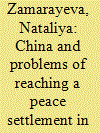

|
|
|
|
|
| Summary/Abstract |
This article analyzes China's position on reaching a settlement on the crisis in Afghanistan. The dynamic of Beijing's approach is described with allowance for inter-Afghan and regional challenges: strengthening the armed opposition in Afghanistan, its influence on the Muslim Uighurs of Xinjiang, and strengthening the strategic partnership between the United States and India in the region. The year 2015, when Beijing and Islamabad signed an agreement to create a China-Pakistan economic corridor (CPEC), was a landmark for the region.
|
|
|
|
|
|
|
|
|
|
|
|
|
|
|
|
| 2 |
ID:
151879
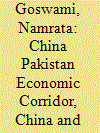

|
|
|
| 3 |
ID:
137529
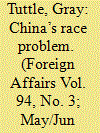

|
|
|
|
|
| Summary/Abstract |
For all the tremendous change China has experienced in recent decades—phenomenal economic growth, improved living standards, and an ascent to great-power status—the country has made little progress when it comes to the treatment of its ethnic minorities, most of whom live in China’s sparsely populated frontier regions. This is by no means a new problem. Indeed, one of those regions, Tibet, represents one of the “three Ts”—taboo topics that the Chinese government has long forbidden its citizens to discuss openly. (The other two are Taiwan and the Tiananmen Square uprising of 1989.)
|
|
|
|
|
|
|
|
|
|
|
|
|
|
|
|
| 4 |
ID:
081504
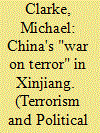

|
|
|
|
|
| Publication |
2008.
|
| Summary/Abstract |
The paper argues that violent Uighur separatism and terrorism conforms in a number of important respects to the human security theory of terrorism, particularly in the realm of political and civil rights. However, it argues that impetus has been given to the various separatist organisations in the region by the development of interconnections between the largely internal aspects of China's policy of integration in the region and the wider Central and South Asian dynamic of Islamic radicalism since 1990
|
|
|
|
|
|
|
|
|
|
|
|
|
|
|
|
| 5 |
ID:
160677
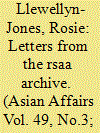

|
|
|
|
|
| Summary/Abstract |
In 2004 a collection of thirty-four letters from the Silk Road explorer Sir Aurel Stein was found in the archives of the Royal Society for Asian Affairs and catalogued, although not transcribed or studied. Neither of Stein's biographers, Jeannette Mirsky (published 1977), nor Annabel Walker (published 1995) knew about these letters, and there are no references to them in more recent publications either. What is perhaps even more interesting is that the Society's letters are addressed to a man whose name does not appear in any published works on Stein; a man who remains an elusive figure more than half a century after his death – Colonel Reginald Schomberg D.S.O. (1880-1958), an explorer and spy. This article analyses the contents of the letters, which shed light on a secret mission undertaken by Schomberg in Chinese Central Asia in the early 1930s.
|
|
|
|
|
|
|
|
|
|
|
|
|
|
|
|
| 6 |
ID:
153005
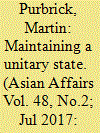

|
|
|
|
|
| Summary/Abstract |
This essay reviews the history of Uighur related terrorism in Xinjiang as well as elsewhere in China and discusses the political motivations and effectiveness of the Chinese government in suppressing terrorism. The essay assesses both the motivations of the Uighurs engaged in terrorism, as well as the motivations for counter terrorist by the Chinese authorities. A key objective of the essay is to determine what are the political and other reasons that drive the Chinese government’s counter terrorism strategy and tactics and whether these have been effective or counter-productive. The essay assesses the counter terrorism strategy of the Chinese government in Xinjiang Province and across China, the political motivations for the strategy, the impact and success or otherwise. The essay discusses if the government is combatting terrorism, or separatism, or extremism, the confusion of these terms, and whether this has had any impact on the effectiveness of counter terrorism.
|
|
|
|
|
|
|
|
|
|
|
|
|
|
|
|
| 7 |
ID:
126293
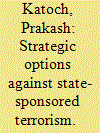

|
|
|
| 8 |
ID:
161500
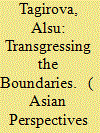

|
|
|
|
|
| Summary/Abstract |
After World War II, suffering from a severe workforce shortage and unprecedented economic devastation, the Soviet Union encouraged the immigration of Chinese citizens from Xinjiang into Soviet Central Asia. Despite the arbitrary behavior of local authorities, the immigrants were successfully integrated into Soviet society. But after 1963, many of the Chinese “defectors” began to be considered a threat to national security, and the KGB (Committee of State Security) arrested a good number of them. I argue that the Sino-Soviet split affected the mentality and immigration policies of the Soviet Union, much like current relations between China and the Central Asian states shape the attitude of the latter toward new arrivals from China. This article is based on research in the Kyrgyz and Kazakh archives.
|
|
|
|
|
|
|
|
|
|
|
|
|
|
|
|
| 9 |
ID:
134142
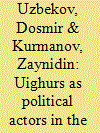

|
|
|
|
|
| Publication |
2014.
|
| Summary/Abstract |
In the Middle Ages, the Uighurs, who are one of the oldest and largest peoples of Central Eurasia (CE), were driven into East Turkestan and then conquered by the Qing Empire. The Chinazation policy carried out in relation to these people led to the mass exodus of the freedom-fighting Uighurs to the CE countries.
The Uighurs are vigorously engaged in economic activity; in other spheres they are traditionally closed and alienated from the outside world, which prevents them from becoming actively integrated into contemporary society.
This article analyzes the roots and reasons for this social phenomenon, which is having a certain influence on the foreign and domestic policy of the Kyrgyz Republic (KR), as well as on political stability and security of the entire Central Asian region.
|
|
|
|
|
|
|
|
|
|
|
|
|
|
|
|
| 10 |
ID:
115435
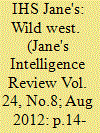

|
|
|
| 11 |
ID:
129458
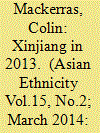

|
|
|
|
|
| Publication |
2014.
|
| Summary/Abstract |
Several major disturbances in Xinjiang in China's northwest in 2013 have further exacerbated the already tense ethnic relations between the Han Chinese and the main minority in Xinjiang, the Uighurs, who are Turkic and Muslim. The Chinese state blames terrorism but most Western journalists remain sceptical. This article argues that terrorism is indeed a real threat, but the Chinese state tends to overreact to disturbances, exacerbating the problems. China's response has included befriending countries further west, including Turkey. The outlook is not good for ethnic harmony, but the region is likely to develop economically and the prospects for independence or quasi-independence from China are very poor
|
|
|
|
|
|
|
|
|
|
|
|
|
|
|
|
| 12 |
ID:
138963
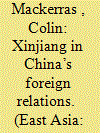

|
|
|
|
|
| Summary/Abstract |
This paper analyses how the situation in China’s most northwestern province-level unit Xinjiang has affected China’s overall foreign relations since disturbances in its capital Ürümqi in July 2009. Xinjiang’s most populous ethnic group is the mostly-Muslim Uighurs. The paper assumes a framework that puts a high priority on China’s facing west. Though no more important than the eastward-looking foreign policy that has dominated Western analysis, the paper sees China’s facing west perspective as deserving more attention than it has received. Russia and Central Asian countries have been positive about China’s economic aims in the region. However, friction has increased with China’s rise, Chinese authorities tending to blame Xinjiang’s disturbances on Islamism in Central Asia. China resents the USA for giving asylum to Rebiya Kadeer, president of the anti-China World Uyghur Congress. In 2011, US Secretary of State Hillary Clinton pushed the idea of a “New Silk Road” in Central Asia for peaceful economic development. China has long espoused the “Silk Road” idea, developing its own “Silk Road Economic Belt.” Damaged due to the 2009 riots, the China-Turkey relationship has improved because of various visits and agreements since 2010. The paper balances the dominantly economic Silk Road concept against Islamist terrorism. It argues that the aims of the Silk Road and Silk Road Economic Belt are sensible and practical, with positive economic relations the main trend. However, although the Central Asian “zone of conflict” is a lesser trend, tensions are serious and long term, especially those caused by Islamism and Islamist terrorism.
|
|
|
|
|
|
|
|
|
|
|
|
|
|
|
|
|
|
|
|
|